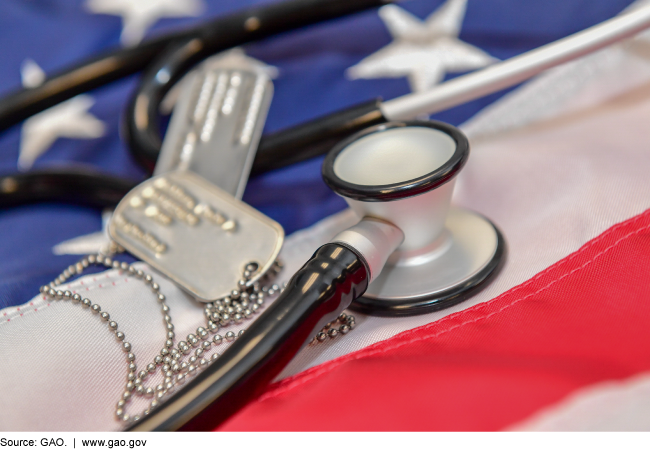Veterans Health Care: Opportunities Remain to Improve Appointment Scheduling within VA and through Community Care
Fast Facts
Most veterans using VA health services receive medical care in VA-operated facilities, including 172 medical centers and over 1,000 outpatient facilities.
For years, we have documented VA’s struggle to provide timely medical care. We testified about VA’s efforts to address some of our recommendations on how to improve.
For example, veterans may be referred to a non-VA provider from the community if timely care is not available. However, we found that VA was not measuring wait times for this community care. We recommended VA compare community care wait times with those at VA facilities.
VA health care is a topic on our High Risk List.

A stethoscope and dog tags on an American flag
Highlights
What GAO Found
GAO has issued several reports recommending that the Department of Veterans Affairs (VA) take action to help ensure its facilities provide veterans with timely access to medical care. VA has taken a number of steps to address GAO's recommendations to improve wait-time measurement and its appointment scheduling policy. However, additional actions are needed to fully address most of GAO's recommendations.
GAO found in 2012 that outpatient appointment wait times reported by VA were unreliable because VA did not ensure consistency in schedulers' definitions of the dates by which wait times were measured. GAO recommended that VA clarify these definitions. VA concurred and has taken a number of actions in response, including improved oversight through scheduling audits. However, VA's first internal audit in August 2018 was unable to evaluate the accuracy and reliability of its wait-time data due to the lack of business rules for calculating them, indicating that additional efforts are needed to address this issue.
GAO also found in 2012 that not all facilities GAO visited used the electronic wait list to track new patients that needed medical appointments, as required by VA's scheduling policy. This put patients at risk for being lost for appointment scheduling. GAO recommended VA ensure consistent implementation of its policy, and that all schedulers complete required training. VA concurred, and with the information VA provided in July 2019 GAO considers VA's actions, including updating its scheduling policy and completing scheduler training, sufficient to fully address the recommendation.
While improvements to VA's scheduling policy and processes will help ensure veterans receive timely access to care, there are other factors that may also affect access that are not currently reflected in VA's wait-time data. For example, GAO found instances in which the time it took the agency to initially enroll veterans in VA health care benefits was more than 3 months.
GAO has also made recommendations to improve appointment scheduling and ensure timely access to care from non-VA providers in VA's community care programs that remain unimplemented. GAO found in June 2018 that the data VA used to monitor the timeliness of the Veterans Choice Program's appointments captured only a portion of the total appointment scheduling process. Although VA had a wait-time goal of 30 days, VA's timeliness data did not capture certain processes, such as the time taken to prepare veterans' referrals and send them to a third-party administrator. GAO found that if these were accounted for, veterans could potentially wait up to 70 calendar days to see a community care provider. VA officials stated that most recommendations will be addressed with new program tools it plans to implement. For example, VA is implementing a system for referral management and appointment scheduling expected to be available in all VA medical facilities by fiscal year 2021. While technology may be an important tool, VA will also need clear and consistent policies and processes, adequate oversight, and effective training to help avoid past challenges.
Why GAO Did This Study
The majority of veterans utilizing VA health care services receive care in VA-operated medical facilities, including 172 VA medical centers and more than 1,000 outpatient facilities. For nearly 20 years, GAO has reported on the challenges VA medical facilities have faced providing health care services in a timely manner. When veterans face wait times at VA medical facilities, they may be able to receive services from VA's community care programs, which VA estimates will be 19 percent of its $86.5 billion in health care obligations in fiscal year 2020.
This testimony focuses on GAO's large body of work on veterans' access to care and the status of VA's efforts to address GAO's recommendations, including those from GAO's June 2018 report on VA's community care programs and from GAO's December 2012 report on VA's scheduling of timely medical appointments that VA has provided information on through July 2019. It also includes preliminary observations on related ongoing work.
Recommendations
GAO has made a number of recommendations to VA to address timely scheduling and reliable wait-time data for outpatient appointments and through community care. VA generally agreed with GAO's recommendations. As of July 2019, VA has taken actions to fully implement one recommendation discussed in this statement. GAO continues to believe that all of the recommendations are warranted.
